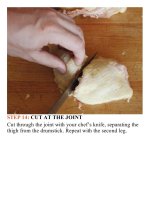The food lab better home cooking through science ( PDFDrive ) 1084
Bạn đang xem bản rút gọn của tài liệu. Xem và tải ngay bản đầy đủ của tài liệu tại đây (185.58 KB, 2 trang )
crustthatwaslighterandcrisper,withincreasedsurfacearea
(and we all know that more surface area = more crispness,
right?).
Finally,Iusedatrickthatafriend,aformeremployeeof
the Chick-fil-A Southern fast-food fried-chicken chain had
told me about. He’d mentioned that once the chicken was
breaded, the later batches always come out better than the
earlier ones as bits of the flour mixture clumped together,
making for an extra-craggy coat. Adding a couple
tablespoons of buttermilk to the breading mix and working
it in with my fingertips before dredging the chicken
simulatedthiseffectnicely.††
Addingbuttermilktothedredgecreatestheextra-craggy
surfaceontheleft.
The last problem—the coating overcooking long before
thechickeniscookedthroughtothecenter—wassimpleto
solve.Justfrythechickenuntilgoldenbrown,thentransfer
it to a hot oven to finish cooking at a gentler pace. The
result is chicken with a deep brown, craggy crust that’s
shatteringly crisp but not tough and that breaks away to
meatthatburstswithintenselyseasonedjuicesunderneath.
EVEN-CRUNCHIERFRIED
CHICKEN?
I
was chatting with my friend the San Francisco
chef Anthony Myint a while back, when he
mentioned that whenever he has leftover fried
chicken, he’ll fry it in hot oil again the second day,
resultinginchickenthat’sevenbetterthanitwasthe
first day. Normally there’s a limit to how much
moistureyoucandriveoutthecoatingonapieceof
friedchicken,definedbyhowlongyouleaveitinthe
oil. Let it get too hot, and the exterior will start to
burn. But if you let it cool overnight, some of the
moisture from the inner layers of coating will work
theirwaytowardtheexterior.Whenyoufryitagain
the second day, this moisture is driven off, leaving
youwithanextra-thicklayerofdehydratedcoating
aroundyourchicken.
Notonlyisitagreatwaytotreatleftovers,butif









